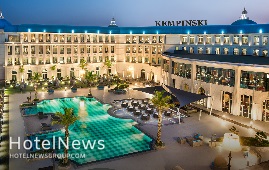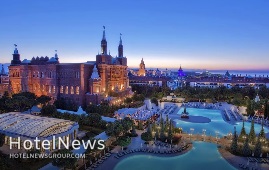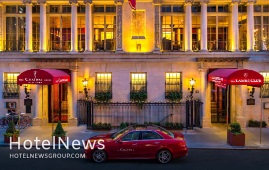
The Global Hotel Alliance (GHA), the world's largest alliance of independent hotel brands with 40 hotel brands, has announced a new record in 2023.Celebrating its twentieth anniversary, the alliance witnessed a 20% increase in Gross Operating Revenue (GDR) compared to 2022. Additionally, the number of reservations surged by 30%, with a 25% increase in member hotels. GHA also expanded into 10 new markets in 2023. This success is attributed to various factors including GHA's focus on innovation and technology, providing unique services and benefits to member hotels, and establishing a strong network of independent hotels worldwide.
Create: Feb 23, 2024 Edit: Feb 23, 2024 International News
The Most Luxurious Hotel in Zurich Opens: Mandarin Oriental, ZurichThe Mandarin Oriental, Zurich, heralded as the city's most luxurious hotel, has officially opened its doors. This hotel is a remarkable transformation of the 185-year-old Baur au Ville, the city's inaugural luxury hotel, with a meticulous $93 million renovation. With 80 opulent guest rooms starting at 800 Swiss francs per night, the Mandarin Oriental, Zurich stands as both the oldest and newest five-star haven in the city.
Create: Feb 23, 2024 Edit: Feb 23, 2024 International News
Ozhotels, recognized as a leading hotel group in Turkey, has signed a contract with Marriott, the world's largest hotel chain brand, to open two new hotels in Antalya. The regional manager of Ozhotels in Antalya stated: "We are proud to collaborate with the Marriott brand to open these two new hotels in Antalya."These hotels will contribute to the improvement of the tourism industry in Antalya and provide quality services to guests from around the world. The chairman of the Ozhotels board also expressed satisfaction with this collaboration, stating: "This is a significant milestone for Ozhotels.""We are collaborating with the Marriott brand, one of the most recognized brands in the hotel industry, to provide a unique experience for our guests in Antalya." The opening of these two new hotels will create new job opportunities in Antalya and contribute to the economic prosperity of the region.
Create: Feb 23, 2024 Edit: Feb 23, 2024 International News
The tourism industry started 2024 reservations early. Tourism professionals say that demand from abroad is more intense than last year, and that prices will increase by 20 percent in foreign currency in 2024. The European market in the tourism sector will grow in the range of 10-15% in 2024, while the CIS market will remain the same, especially drawing attention to the growth in the UK market. It is estimated that travel will increase by 5-10% in 2024. Industry representatives are of the opinion that the European market will grow in the 10-15% range, while the CIS market will remain the same. President of the Mediterranean Touristic Hoteliers and Operators Association, stated that the first reservations came from the British market, and 50% of the sales were completed from the British market at the beginning of the new year.
Create: Jan 25, 2024 Edit: Jan 25, 2024 International News
Radisson Hotel Group completed 2023 with extraordinary growth, adding more than 30,000 rooms to its international portfolio of 10 leading brands with new openings and agreements. With these results, Radisson Hotel Group has grown its operations by 50% since 2018, when the transformation plan began. In 2023, Radisson Hotel Group broke a new record with the agreements and openings of more than 30,000 rooms added to its portfolio. Radisson Blu, the group's leading brand, continued to be Europe's largest upper segment brand for the 12th time in a row. Head of Global Development, Radisson Hotel Group, said: We are grateful to our friends. We expect 2024 to be a continuation of 2023 as inflation slows down and investors' interest in the sector continues.
Create: Jan 25, 2024 Edit: Jan 25, 2024 International News
Chatwal Hotel is one of the hotels of dream hotel group This hotel, which is on 10 floors with 76 rooms and 43 suites, is located in the heart of New York. Room service, spa, sports club and swimming pool are provided free of charge in this hotel. It also has a luxury restaurant located next to the theater which guests can visit before or after watching the theater. Chatwal Hotel also provides baby care services to its guests. Spa facilities in this hotel include steam room, sauna and private lounges that help you to escape from the hustle and bustle of the city. For business meetings, it has a conference center that consists of several offices and meeting rooms.
Create: Oct 22, 2022 Edit: Oct 22, 2022 TV
Historic hotels around the world you must add to your buncket list Alfonso XIII Hotel - Spain Alfonso XIII Hotel is one of the most beautiful 5-star hotels in Spain, which was built in 1928. The hotel has 151 luxurious rooms with full facilities; 19 single rooms 55 double rooms 55 duplex rooms 22 royal suites for families with many children. This hotel has 3 restaurants, the main restaurant called San Fernando is located in the central courtyard of the hotel and serves classic Spanish dishes and wines. Ena Sevilla restaurant is located on an open terrace and pricents a view of the city center and serves a variety of tapas and cocktails. The poolside restaurant also serves variety of snacks and fruit drinks. This hotel also has spa facilities, sports club and swimming pool.
Create: Oct 22, 2022 Edit: Oct 22, 2022 TV
Historic Hotels Around the World you Must Add to your Bucket List Hotel Hill front kesroli - India The 14th century Hill Fort-Kesroli is one of the oldest heritage sites in India The reservation of the rooms of this hotel is done only through the online reservation system, and guests can contact the hotel directly to book the room Only when they want a reservation for the same day. There is no TV in the hotel rooms and there is no room service. In the hotel restaurant, Indian dishes are served along with dishes from other continents to suit most tastes. Also, French, Italian, Chinese and Thai dishes are offered to complete the poolside restaurant buffet. This hotel is an ideal base for visiting the palaces, museums, natural sites and sanctuaries of Sariska and Alwar.
Create: Oct 22, 2022 Edit: Oct 22, 2022 TV
Hotels that we look forward to their exciting opening in 2022 Part 3; Nobu Santorini Hotel- Greece 🇬🇷 The 26th branch of Nobu Hotel in Greece will be opened in Santorini Nubo hotel architect Designed in the traditional whitewashed Cycladic style with minimalistic décor to optimally enhance the dramatic vistas beyond. Nobu Hotel Santorini offers 25 stunning accommodations, all with breathtaking views of the Caldera and the Aegean Sea. It offer a nobu restaurant, luxe spa, fitness center, two level infinity pool and five pool villas Nobu hotel opening this spring is also just 20 minutes from santorini international airport. It also offers a unique blend of Japanese hospitality and stunning Santorini and Whether you’re looking for Nobu Hotel classics or locally packages, explore our offers to find the stay that suits you best.
Create: Oct 22, 2022 Edit: Oct 22, 2022 TV
Hotels that we look forward to their exciting opening in 2022 Part 2 Ritz-Carlton Hotel in NewYork🇺🇸 Ritz-Carlton hotel in Manhattan’s was newly-built from the ground up with 250 guest rooms and 16 luxury penthouse residences. It will feature two new restaurants and a rooftop bar Guest Room Features & Amenities Daily housekeeping service and evening turndown service High-speed wireless Internet access Large flat-screen televisions Same 24 hour laundry services Online Keyless entry via Marriott Bonvoy App Guests can also chill out in the hotel’s signature Ritz-Carlton Spa and Fitness Center. the spa facilities include steam room, sauna, and private lounges to help you escape the hustle and bustle of the city. Visit the modern sensibility of some of the greatest art museums in the world just blocks away
Create: Oct 22, 2022 Edit: Oct 22, 2022 TV
Hotels that we look forward to their exciting opening in 2022 Part 1 CONRAD TULUM RIVIERA MAYA Hotel in Mexico🇲🇽 The hotel is the newest luxury addition to the Hiltons hotels portfolio CONRAD is known for its contemporary style the modern design sets the brand apart from waldorf astoria hotels and symmetry is key element at this particular property hotel. Rooms are arranged in several buildings along the shore line and at the topmost floor, the view of the sea is spectacular The hotel boasts five different restaurant. The main pool bar is the centerpiece of the hotel and in the evening the guests can enjoy drinks while listening to live music or dj performances Guests have multiple options of getting around the hotel they can order a golf car, take a bike or walk along the jungle paths The gym located in the basement of the hotel, yoga and spinning classes are offered throughout the week
Create: Oct 22, 2022 Edit: Oct 22, 2022 TV
